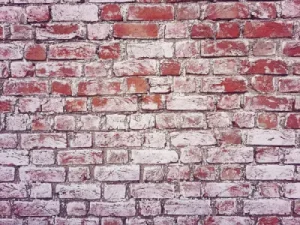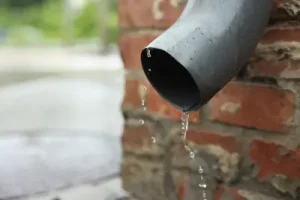in Portland OR and Vancouver WA areas

This is a stair-step crack, a common sign of possibly serious damage to masonry and brickwork.
There is a sense of permanence to a brick structure. Each brick is a solid, hefty block, and when joined with thousands of others, it creates a structure that feels like it can stand the test of time. After decades of masonry work in Portland, we’ve heard many homeowners ask, “Do I really need masonry repair, or am I just overreacting to a few cracks?” It’s a valid concern. No one wants to spend money they don’t need to. However, delaying a repair can turn a small fix into a costly project.
Understanding how to tell when you need brick repair or replacement is the first step in ensuring your property stands tall for generations to come.
How to Know When You Need Masonry Repair
First, you have to look for what we call “active deterioration.” These are signs that damage is ongoing rather than old and stable. So check the wall bases where splash-back happens, by downspouts, and under windowsills.
Signs You Should Call a Masonry Pro:
- Spalling, Flaking, and Chipping: This is when the face of the brick begins to crumble, pop off, or flake away. It’s one of the most visible signs of distress. Spalling indicates that moisture has penetrated the brick’s exterior. During a freeze, this trapped water expands, exerting incredible force from the inside out, causing the brick to spall, flake, or chip.
- Stair-Step or Widening Cracks, Especially Near Corners or Openings: These types of cracks often indicate foundation settlement or shifting, which can compromise the structural integrity of the entire wall.
- Persistent Damp Walls, Peeling Paint, Musty Odors: These are strong indicators of moisture intrusion. Water can seep through compromised brickwork or mortar, leading to interior damage, mold growth, and an unhealthy indoor environment.
- Cracked or Crumbling Mortar: The mortar joints are the first line of defense for your brick wall. If you see gaps, cracks, or find that the mortar starts to disintegrate when you touch it, that defense is weakening.
- Bulging or Bowing Walls: Stand back from your building and look down the length of the wall. Does it appear to swell outwards in the middle? A bulging or bowing wall is a serious structural red flag.
- Efflorescence: Have you noticed a chalky, white residue on your brick? This is efflorescence, which is salt deposits left behind as trapped water evaporates out of the brick. While easy to clean off, it’s a clear indicator of an underlying moisture problem.
- Deteriorating Lintels: The steel or concrete beams that span the top of your windows and doors are called lintels. If you see rust staining the bricks around them, or cracks forming at the corners of your windows, it’s a sign the lintel is failing. As it rusts, it expands, putting immense pressure on the surrounding bricks.
Need an Estimate for Masonry Services?
Contact us now to schedule your in-person consultation!Do I Need Masonry Repair or Replacement?
Repairs are often feasible when issues are specific, the structure is level, and moisture is under control. Restoration or rebuilding may be best when large sections are loose, freeze-thaw damage is widespread, or prior improper repairs have failed.
More on Common Problems That May Require Brick Repair or Replacement
Our region’s weather patterns create what we call the “freeze-thaw cycle.” Water seeps into small cracks in the rainy season, which then expands when temperatures drop below freezing. This constant expansion and contraction work like tiny jackhammers in your masonry, slowly widening cracks and loosening mortar joints.
Add in the moss and vegetation that thrive in our climate, and you have biological factors working against your masonry as well.
Here’s what we run into at Masonry Waterproofing, and Drainage Masters:
Spalling Brick and Face Pop-Offs
- The cause?: Trapped moisture and freeze-thaw in hard mortars on soft brick.
- How it’s fixed: Spalled units replacement, repointing with compatible mortar, breathable sealer application, and addressing sources of water.
Widening Cracks and Stair-Step Patterns
- The cause?: Settlement, thermal movement, and seismic activity.
- How it’s fixed: Helical bar stitching, repointing, control joints, and foundation evaluation for root causes.

The appearance of this white powder on brickwork is known as efflorescence. It’s a sign you may need professional repairs.
Efflorescence and Interior Moisture
- The appearance of this white powder on brickwork is known as efflorescence. It’s a sign you may need professional repairs.The cause?: Vapor drive and trapped salts.
- How it’s fixed: Source control (flashing/weep/grade), gentle cleaning, repointing, or breathable sealers.
Leaking Chimney or Fireplace
- The cause?: Failed crown, missing cap, bad flashing, cracked flue, or smoke chamber.
- How it’s fixed: Crown rebuilds, stainless caps, step/Counter-flashing, smoke chamber parging, and flue liner repair or replacement.
Bulging or Bowing Walls
- The cause?: Water intrusion, corroded ties, or inadequate support.
How it’s fixed: Partial rebuild, new anchors or ties, lintel replacement, and drainage improvements.
Need an Estimate for Masonry Services?
Contact us now to schedule your in-person consultation!Critical Areas to Monitor for Brick Damage
Foundation
Masonry foundation repairs are some of the most critical work we perform. Foundation cracks come in two types: normal settling and structural movement.
Hairline vertical cracks can happen from normal concrete curing or slight settling. However, horizontal cracks, stair-step patterns in block foundations, or any crack wider than a quarter-inch demand immediate professional evaluation.
Chimney
We’ve seen how chimney problems often go unnoticed until they become severe. Your chimney faces harsh weather and handles extreme temperature changes from your fireplace, accelerating deterioration.
Fireplace
Cracked firebricks, worn mortar joints, and damaged smoke chambers look bad, creating real fire hazards. Heat stress poses special repair challenges and standard mortars can’t handle the high temperatures of fireplaces.
How Do Bricks Get Damaged?
Your brickwork faces steady wear and tear every day. Common causes include:
- The Freeze-Thaw Cycle: Water seeps into cracks, freezes, expands, and makes the cracks bigger. This cycle is the primary cause of spalling and mortar degradation in climates like ours.
- Foundation Movement: As the soil beneath your property settles, shifts, or swells, it puts immense stress on the brick structure above, leading to significant cracking.
- Poor Drainage: Clogged gutters and downspouts that deposit water right at the foundation saturate the ground and the brickwork itself, potentially leading to big problems.
- Impact and Abrasion: From accidental vehicle bumps to years of wind-driven rain, physical forces can slowly erode or acutely damage brick and mortar.
- Construction Flaws: Errors made during construction, such as the use of an improper mortar type or the failure to install wall ties and flashing correctly, can create flaws that turn into problems years later.
Can You Prevent Brick Damage or Degradation?

Having your downspout too close to your brickwork or foundation will lead to significant wear and tear.
Yes, you can absolutely take proactive steps to protect your brickwork and extend the life of your masonry. Here’s what we recommend:
- Perform Regular Visual Checks: Twice a year, in the spring and fall, walk around your property and look closely at the walls, foundation, and chimney. Catching a small crack early is far better than discovering a major failure later.
- Prioritize Gutter and Downspout Maintenance: This is the single most effective thing you can do. Ensure your gutters are clean and that downspouts extend several feet away from your foundation. This will significantly reduce the wear and tear on your masonry.
- Control Your Landscaping: Trim back any trees or shrubs that touch the brickwork. Avoid piling mulch against the foundation, as it traps moisture. Ensure sprinklers aren’t spraying directly onto your walls.
- Consider Professional Sealing: For brick that is particularly porous or exposed to harsh weather, a professional-grade, vapor-permeable water repellent can provide an excellent layer of protection. This is a job best left to experts to ensure the right product is used.
What Are the Risks of Damaged Bricks?
So, you’ve noticed a few cracks or some crumbling mortar. It’s easy to put it on the back burner — after all, it’s just a few bricks, right?
Well, not so fast. The danger lies in what these visible symptoms represent. A small crack is like a dripping faucet; ignoring it doesn’t just waste a few drops. Those drops add up and eventually lead to a much larger, more expensive problem.
- Catastrophic Water Damage: Damaged brick and failing mortar may draw water deep into your wall cavity, and when it does, this moisture doesn’t stay there. It can lead to wood rot in your building’s frame, ruined insulation, and foster the growth of black mold, creating a serious health risk.
- Structural Failure: The most severe risk. A bulging wall or a foundation compromised by water can eventually lead to a partial or total collapse. What begins as a cosmetic issue can escalate into a genuine threat to safety and the structural viability of your entire property.
- Pest Infestations: Small cracks and gaps in your mortar are open doorways for insects, rodents, and other pests looking for a new home. They can quickly turn a minor masonry issue into a full-blown infestation within your walls.
- Reduction in Property Value: Damaged brickwork is one of the first things potential buyers, appraisers, and inspectors notice. It often hints at deeper, hidden problems, significantly reducing the curb appeal and market value of your home or business.
Masonry and Chimney Repair Services We Offer
- Brick masonry repair with selective replacements or face-bedding and stitching cracked brick with helical bars.
- Wall repair by rebuilding bulged sections, installing ties and anchors, and replacing failing lintels.
- Chimney masonry with crown rebuilds, crack repairs, cap installation, and flashing replacement.
- Foundation repair with rack assessment and stabilization, and underpinning where needed.
- And much more to restore your home’s structure.
Expert Masonry Repairs and Replacement Since 2008
Your masonry structures (whether foundation, walls, chimney, or fireplace) protect your most valuable investment. Regular inspections and repairs stop small problems from turning into big costs.
Every crack has a story, and every Portland property deserves protection from our climate.
Not sure when you need masonry repair? We’ll show you exactly what’s happening, why it’s happening, and the simplest way to fix it on your schedule and budget. Contact us today for an inspection and honest recommendations.
Back to Masonry Services

